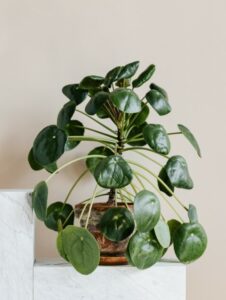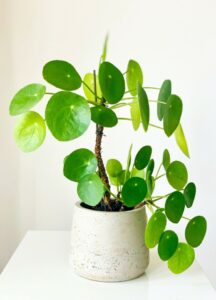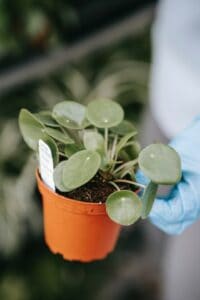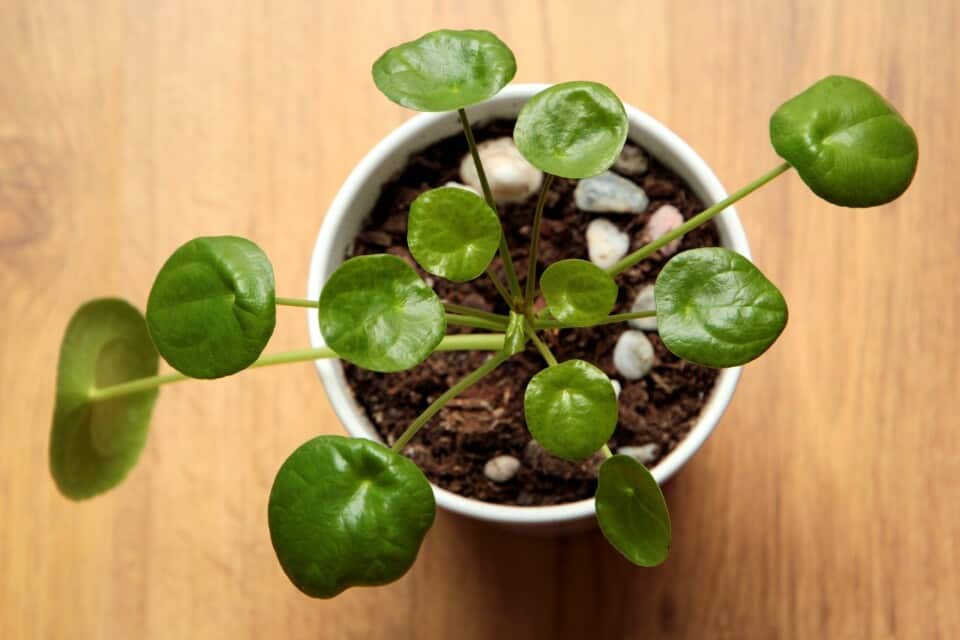Some links in the post are affiliate links and I get a commission from purchases made through some links found in the post.
Suppose you have a Pilea Peperomioides, also known as Chinese Money Plant, or are thinking of buying one.
In that case, you might wonder what the ideal humidity for the plant could be since it is known to be picky about the humidity levels.
But don’t worry since we have got you covered with all the necessary info you need for your money plants care.
Pileas are tropical plants that are native to southern China. The pilea grows best at 65-75° F (almost 18 to 24 degrees Celsius) and prefers humidity levels of about 40-60%.
The plant requires increased humidity if you live in a dry area. You can add to the air humidity to benefit your Pilea. This can be achieved by using a humidifier or directly misting your Pilea twice a week.
Although the requirements may sound simple if you’re new to caring for plants, adjusting humidity levels may not be a piece of cake.
If you want to find out in detail all the tips and tricks to keep your Pilea healthy, green, and growing, then keep on reading.
How to Find out what Humidity your Home is?
 If you want to measure the humidity of your plant quickly and reliably, you can use a hygrometer. A hygrometer is a device that records the indoor temperature while measuring the humidity level.
If you want to measure the humidity of your plant quickly and reliably, you can use a hygrometer. A hygrometer is a device that records the indoor temperature while measuring the humidity level.
This device, of course, is helpful if you want to maintain the exact humidity levels for your plant in your home. This is for those people who have a green thumb and want to keep their plants happy.
Other methods to assess the humidity levels include checking the windows for condensation during the winter or excess mildew in the bathroom.
Mold growing on the interior, peeling, and cracking of paint are the significant visible indicators that you have a high humidity level in the house. The ice cube test is a specific test to determine humidity levels.
If you place a few ice cubes in a glass and moisture does not form on the outside surface of the glass, this shows that the air is too dry, and you may require a humidifier to provide your plant with the ideal humidity.
On the other hand, if water has condensed on the outside surface of the glass, this shows that the humidity level is high.
Humidity changes depending on the outside temperature, so you need to measure the humidity levels frequently. You can manage the humidity by using a humidifier or a dehumidifier system.
How to Increase the Humidity in your Home?
Higher levels of humidity are suitable for many household plants. In addition, most of the plants native to tropical regions require higher humidity.
There are many ways by which you can increase the moisture of your house. Some of the methods include:
1) Humidifier
A straightforward way is to use a humidifier. Humidifiers increase the relative humidity in the surrounding air by adding moisture, and they do this by adding mist, increasing the level of water droplets, thus increasing the relative humidity.
2) Add Houseplants
Another way of increasing the humidity levels includes adding house plants to your home. The plants release water through transpiration and evaporation.
3) Adjust Daily Water-linked Activities
Using shower steam, boiling water on a stove, letting bathwater sit for a while, or using vases of water also increases humidity.
Not using a dryer and hanging the laundry to dry is also a simple way to increase the moisture.
4) Place the Plant in a Humid Location
If you want to increase the humidity around your Pilea plant, you can place the indoor plant in the bathroom, laundry room, or the kitchen where the humidity levels are already high.
5) Group Plants Together
You can also group your Pilea pots together and place a water tray in the middle. This also helps the plants since evaporation from the tray coupled with transpiration will increase the humidity.
6) Mist the Plant
Another commonly used and simple way is to mist the plant, although this is temporary. Misting involves only spraying the top of the plant with water.
Remember that misting is not the same as watering. Watering involves only adding water to the soil when the top half-inch of the soil is dry.
Otherwise, the root may be susceptible to root rot. Watering can also be top watering wetting the leaves as well.
But take care that the leaves don’t drip water or retain water for too long, making them susceptible to fungal infestations.
7) Pebble/ Gravel Tray
You can also increase the humidity by placing a layer of pebbles or gravel in the tray, adding water to the pebbles or gravel, and setting the plants on top.
The pebbles hold the plant above the water. As the water in the tray vaporizes, the moisture in the air around the plant increases.
8) Use a Terrarium
Placing the plants in a terrarium is also an excellent way to increase humidity for your house plants. A terrarium involves placing the plants in a closed or semi-open glass container.
A terrarium is a great way to grow water and humidity-loving plants since the contained environment increases the humidity significantly.
In addition, placing a plastic bag or wrap around the plant after misting the leaves increases humidity.
What are the Signs the Humidity is not Ideal for your Pilea?
 Some cardinal signs indicate that the humidity is probably not that ideal for you Pilea. The leaves of the Pilea plant develop browning of the edges in low humidity.
Some cardinal signs indicate that the humidity is probably not that ideal for you Pilea. The leaves of the Pilea plant develop browning of the edges in low humidity.
The edges also curl, turn crisp and brown (Check this article here to help fix your pilea leaves from turning brown). The tips become dry, just as how our skin reacts to low moisture. Any new leaves that had sprouted may not show adequate growth.
The plant may start to wilt if the humidity is really low. The leaves begin to turn yellow in color. The stems and branches of the plant also start to shrink and fade and can turn brown.
The leaves can also begin to droop (Check our article on why is my pilea drooping for more information). The turgor pressure, commonly called water pressure inside the roots, shoots or stems, keeps the plant and its leaves upright.
When there is underwatering of the plant or low humidity, the plant starts to lose this water by the difference in pressure between the plant and the atmosphere.
The process of evaporation of water from the plant leaves occurs by the process of transpiration. Water evaporates more from the leaves in the summer because of the heat.
Does Pilea like to be Misted?
Pilea Peperomioides is a tropical plant, and tropical plants like high humidity levels since this is the environment they usually have in the forest and are adapted to.
The atmosphere in our homes is not as close to the humidity levels the plant typically grows in. So, the Pilea plant no doubt loves to be misted frequently as misting increases the humidity levels.
The Pilea plant prefers hot to room temperatures and does not like cold weather. The humidity is low in cold weather as well.
The humidity fluctuations make it difficult to regulate conditions precisely, but knowing that Pilea likes the upper humidity levels, it becomes easier to maintain conditions.
Misting is simple but requires your attention to the weather to know when your plant might need a spray. It’s even easier to use a humidifier to maintain the humidity levels suitable for the plant.
How to Mist your Pilea?
Misting is a really easy but essential thing to do. It’s just like watering any other leaves of a household plant.
The basics include using a mister or sprayer with a light sprinkler to mist the plant since you don’t want to soak or drench the Pilea leaves entirely in water.
Don’t wet the leaves too much such that they remain soaked in water. Instead, lightly mist the plant whenever you think the humidity has dropped.
Pick a location near your Pilea to place the watering spray bottle, so you’re constantly reminded to mist your plant whenever you walk past.
You can also make a humidifier by using a bowl of water placed near a plant. You can turn on a fan near the bowl so that the water evaporates and provides adequate humidity to the plant.
Keep in mind that you should continuously mist Pilea and other household plants with filtered or distilled water since normal tap water contains a lot of salts that are not needed and can actually be harmful to your plant.
You can also use rainwater for this purpose. However, hard water leaves marks on the leaves, ruining their aesthetic.
Can you Keep Pilea in the Bathroom?
You can definitely keep your Pilea plant in the bathroom since it is the most humid location of the house. The plant, when placed there, would also not require frequent misting.
You should not place a Pilea plant near any heat source, radiator, or fireplace. Any plant placed near a heater can quickly get burned and dried up. Be extra careful with Pilea since it is humidity-loving.
This means not even decorating your doorways or corridors with the plant since the drafts can lower the humidity and cause browning and other damage to the plant. You can also place your Pilea near the kitchen since it is also humid.
Final Thoughts
 Pilea is a humidity-loving plant. The plant desires humidity levels of 50 to 75%. Placing the Pilea plant indoors requires adjusting the house’s humidity according to the plant’s requirements.
Pilea is a humidity-loving plant. The plant desires humidity levels of 50 to 75%. Placing the Pilea plant indoors requires adjusting the house’s humidity according to the plant’s requirements.
Using a hygrometer is an excellent method to keep check of the moisture indoors if you want your plant safe from the effects of low humidity levels.
Signs of low humidity include browning, curling, and crisping of leaves. Misting the plant with a light mist spray bottle is a good way to keep the humidity sufficient for your Pilea since it loves misting.
You can keep the Pilea in a bathroom or near the kitchen since the humid environment favors the plant.
Related articles:
How to Fix a Leggy Pilea & How to Prevent it in the Future
What are the Common Problems With a Pilea?
Pilea Light Requirements: What Type, How Much & Much More
How Big Can a Pilea Get: How Fast & Tips to Grow Them Bigger
About the Author:
Saad Ansar
Saad is an avid gardener himself and is a great lover of plants, animals, photography, & people. Currently, he is focused on photographing indoor plants & captioning beautiful outdoor sceneries. He writes and rewrites in-depth articles on nature and science.

